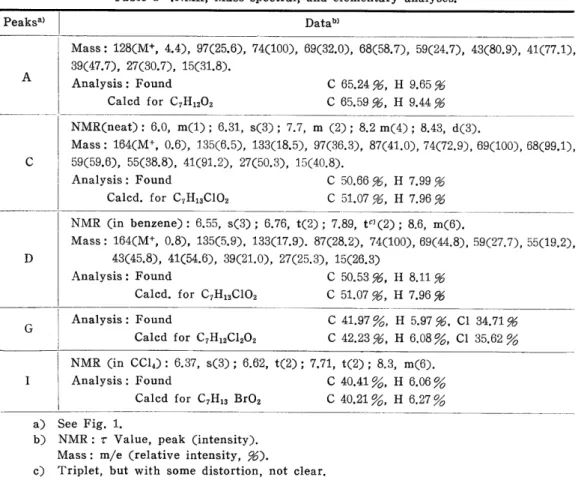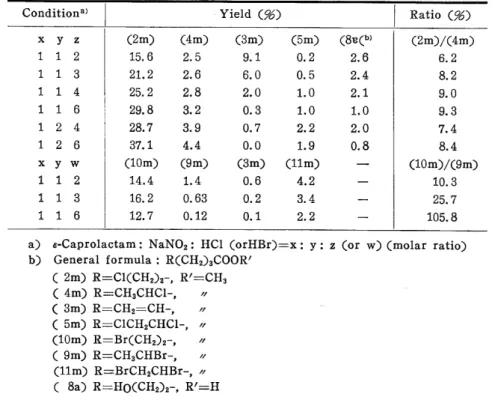THE DECOMPOSITION REACTION OF N-NITROSO-
s-CAPROLACTAM WITH ACIDS
Ichiro HiRAo, Taketoshi KiTo, Hiroshi YAsvNo, and Masanobu OsHiRo
(Received October 20 1972)
S YNOPSIS
A solution of e-caprolactam in aqueous hydrochloric acid was treated with sodium nitrite below OOC, and the resulting N-nitroso compound was decomposed at 60eC. After the conversion of the acids in the reaction mixture into methyl
esters, each component was separated by gas chromatography and identified by NMR and MS. As a result, the components were found to be 5- and 6-chloroca- proic, 5-hexenoic, 5, 6-dichlorocaproic, 6-hydroxy caproic acids, caprolactone, and a high boiling point mixture of which the main component was Cl(CH2)sCOO (CH2)sCOOH. When hydrobromic acid was used in place of hydroch!oric acid, the corresponding bromo-compounds were obtained. The formation process and yield of these compouds, and the effect of the acids on these compounds were also examined.
1. INTRODUCTION
We have reported" on the synthesis of tu-(p-carboxyphenoxy) alkanoic acids arid their dimethyl esters by WMiamson synthesis in one of the investigations for the application of p-hydroxybenzoic acid and then examined the various syntheses of to-haloalkanoic acids in connection with this reaction. In these haloalkanoic acids, 6-halocaproic acid was prepared from the decomposition of N-nitroso-e- caprolactam by hydrohalogenic acids with respect to the material and the opera- tion. In this reaction, it was reported2' that 5-hexenoic acid was formed as aby- product together with 6-chlorocaproic acid when hydrochloric acid was used as an acid. But it was found by gas chromatography that there exsists some other by-products in addition to 5-hexenoic acid. The resu.lts of these tests examining these by-products by gas chromatography, NMR, MS and so on, are reported.
2. EXPERIMENT
2. 1 The Decomposition Reaction of N-Nitroso-e-caprolactam (NCL) with Acids.
One example is described in the following. A solution of 113 g (1 mole) of
e-caprolactam and 170 ml of water was maintained below OeC. To this solution a
prescribed amount of 35 9o hydrochloric acid was added and then a solution of 150
ml of water and a prescribed amount of sodium nitrate was dropped. After that, the mixture was stirred for three minutes at below OeC, and for a further ninety minutes at 60eC and the resulting NCL was decomposed. After thereaction, the mixture was cooled and the products (caproic acid derivatives) were extracted with ether. The ether was distilied off as much as possible, at atmospheric pre-
ssure. '
2. 2 Esterification.
To 80 g of the ethereal extract obtained above, 10 ml of concentrated sulfuric acid and 300 mt of absolute methanol were added and the mixture was refluxed for three hours.
2. 3 Methyl 6-Hydroxycaproate.
A mixture of 50 g of methyl 6-chlorocaproate, 25 g of potassium hydroxide and 100 ml of methanol was heated in an autoclave at 130eC for three hours. Bp 118-119Åé/10mmHg (lit. Bp 1230C/12mmHg3').
2. 4 Methyl 6-Methoxycaproate.
Methyl 6-Methoxycaproate was obtained by Williamson's ether synthesis from sodium methoxide and methyl 6-chlorocaproate in methanol. Bp 101-102"C/19mmHg (lit. 58-610C/2mmHg`)).
2. 5 Dichlorination and Dibromination.
The reaction mixture containing 9.0 g of 5-heptenoic acid was dissolved in 30 ml of tetrachloromethane and 22.0 g of sulfuryl chloride was added dropwise to this solution under reflux for 30 min, and the stirring was continued for another 1 hr.
The addition of bromine was conducted according to the method described in JIS J 2534-1965.
2. 6 Addition of Hydrogen Halide to a Double Bond
To 5-hexenoic acid, 35 0/5 hydrochloric acid or hydrobromic acid, whose amount corresponds to six ,times moles of the former, was added and after stirring at 60- 6sOC for 1.5 hr it was esterified according to the method described in 2.2.
2. 7 Analysis.
Gas chromatography: Yanagimoto GCG 550T; column, 2.25m, PEG 20M; car- rier gas, He; internal standard, diphenylether.
NMR analysis : Japan Electron Optics Lab.
Mass analysis: Hitachi Mass Spectrometer (RMU-6L)-HITAC 10; electron
accelerating voltage of 70eV.
(32)
3. RESULTS AND DISCUSSION.
The mixture of 6-chlorocaproic acid (2a)5' and 5-hexenoic acid (3a), the latter being a by-product, was mainly obtained when the hydrochloric acid solution of N-nitroso caprolactam (NCL) was heated. The outline of the reaction is shown in Equation (1).
(CH,),
O--C/ X NX-NOL'
Cl-
-,År C!(CH,),COOH
N,++(CH,),COOH- -H. (1)
--) CH,-CH(CH,),COOH
First, this reaction product was converted to methyl ester and the composition was determined by gas chromatography. As the esterification is usually fairly good, the loss by esterification was ignored in the following.
An example ofagas chromatogram is shown in Fig. 1. To determine the structure of each component in the gas chromatogram, four components of the peaks A. C, D, and G were obtained separately by gas chromatography. The re- sult of these NMR, MS, and elementary analysis are shown in Table 1.
It was considered from the mass data and elementary analysis that the peak A component is methyl 5-hexenoate (3 m), this structure being also supported by
NMR.
Both molecular weights of the peaks C and D components were 164 (Mass analysis) and the existence of chlorine was confirmed by a flame reaction. The ratios of the intensities of m/e 135 and 133 of both componenents in the mass
130 160 190 220
Temperature (oC)
Fig. 1. Gas chromatogram of esterified mixture Condition : x:y:z == 1:1:6 (See Table 2) Heating rate : 60C/min
(33)
Table 1 .NMR, Mass spectral, and elementary analyses.
Peaksa)
A
c
D
G
Datab)
Mass: 128(M+, 4.4), 97(25.6), 74(100), 69(32.0), 68(58.7), 59(24.7), 43(80.9), 41(77.1), 39(47.7), 27(30.7), 15(31.8).
Analysis: Found C 65.24 %, H 9.65%
Calcd for C7Hi202 C65.59 %,H9.44%
NMR(neat): 6.0, m(1); 6.31, s(3); 7.7, m (2); 8.2 m(4); 8.43, d(3).
Mass: 164(M+, O.6), 135(6.5), 133(18.5), 97(36.3), 87(41.0), 74(72.9), 69(100), 68(99.1), 59(59.6), 55(38.8), 41(91.2), 27(50.3), 15(40.8).
Analysis: Found C 50.66 %, H7.99%
Calcd. for C7Hi3CI02 C 51.07 %, H 7.96%
NMR (in benzene): 6.55, s(3); 6.76, t(2); 7.89, tC)(2); 8.6, m(6).
Mass : 164(M', O.8), 135(5.9), 133(17.9). 87(28.2), 74(100), 69(44.8), 59(27.7), 55(19.2), 43(45.8), 41(54.6), 39(21.0), 27(25.3), 15(26.3)
Analysis: Found C 50.53 %, H 8.11%
Calcd. for C7Hi3CI02 C 51.07 %, H 7.96%
l
I
Analysis: Found C41.97 906, H 5.97 %, Cl 34.71%
Calcd for C7Hi2C1202 C 42.23 %, H 6.08 0/o, Cl 35.62 906.
NMR (in CC14): 6.37, s(3); 6.62, t(2); 7.71, t(2); 8.3, m(6).
Analysis: Found C 40.41 906o, H 6.06 0/o
L l Calcd for C7Hi3 Br02 C40.21 0/o, H 6,27 9016.
a) See Fig. 1.
b) NMR: T Value, peak (intensity).
Mass: m/e (relative intensity, %).
c) Triplet, but with some distortion, not clear.
spectra were about 1: 3. This indicates that both are monochloro compounds.
The elementary analysis value was almost consistent with the calculated one for C7Hi3CI02. It was considered from NMR that the peak C component is methyl 5-chlorocaproate (4m) and the peak D is methyl 6-chlorocaproate (2 m).
On the other hand, it has been reported6' that when a compound with an ethylenic double bond is treated with sulfuryl chloride, the corresponding dichloro- compound is obtained. When the ester mixture containing (3 m) was treated with sulfuryl chloride, the peak A completely disappeared and the intensity of the peak G increased. Therefore, the peak G component is methyl 5,6-dichlorocaproate (5 m). Both the elementary analysis and NMR supported this structure.
The peaks B, F, and E were considered to be methyl 6-methoxycaproate (6a), e-caprolacton (7), and methyl 6-hydroxycaproate respectively, by comparing the retention times of these components with authentic samples.
NCL was decomposed by hydrobromic acid instead of hydrochloric acid and
after the esterification the components were analyzed by gas chromatography. As
a result, the new peaks H, I, and J were detected in addition to the peaks A, B,
,


